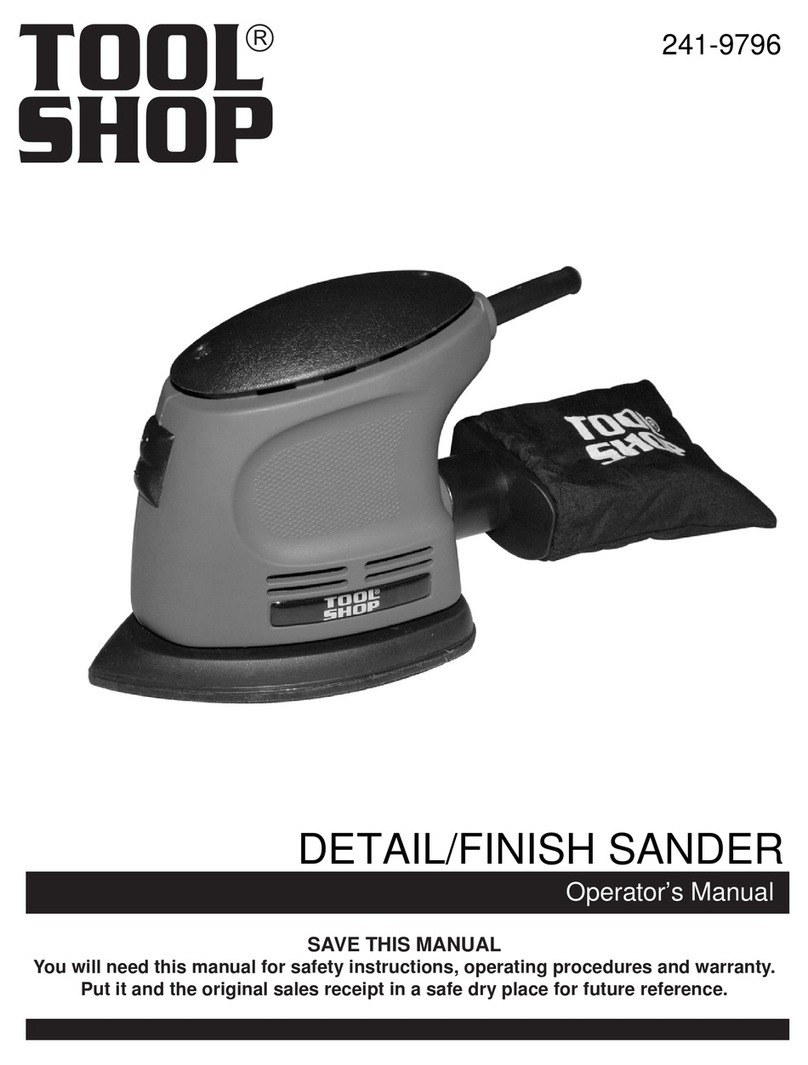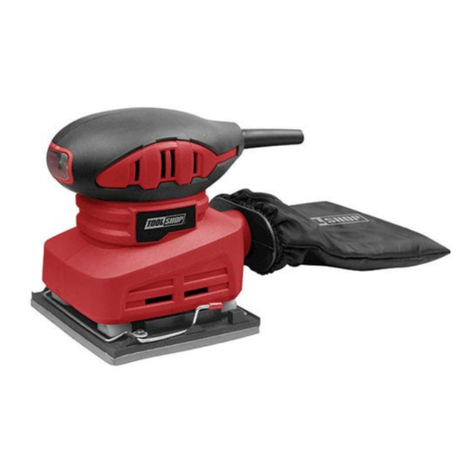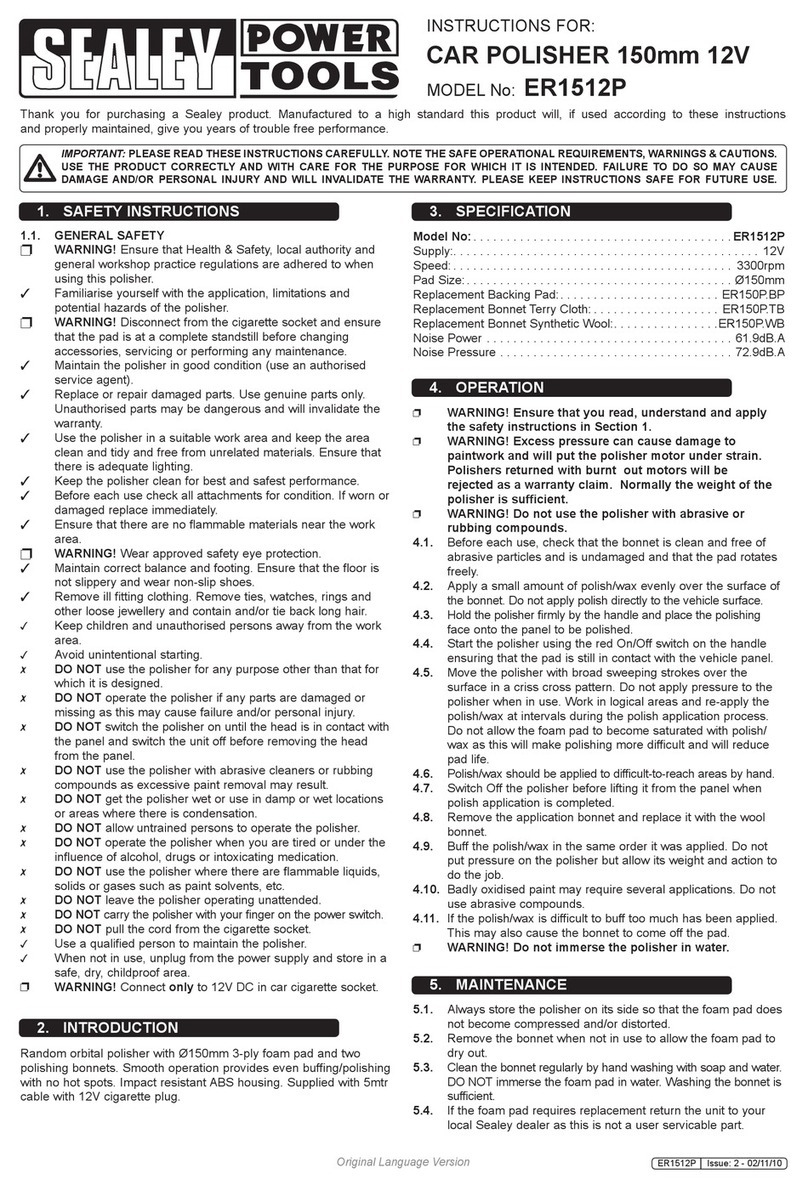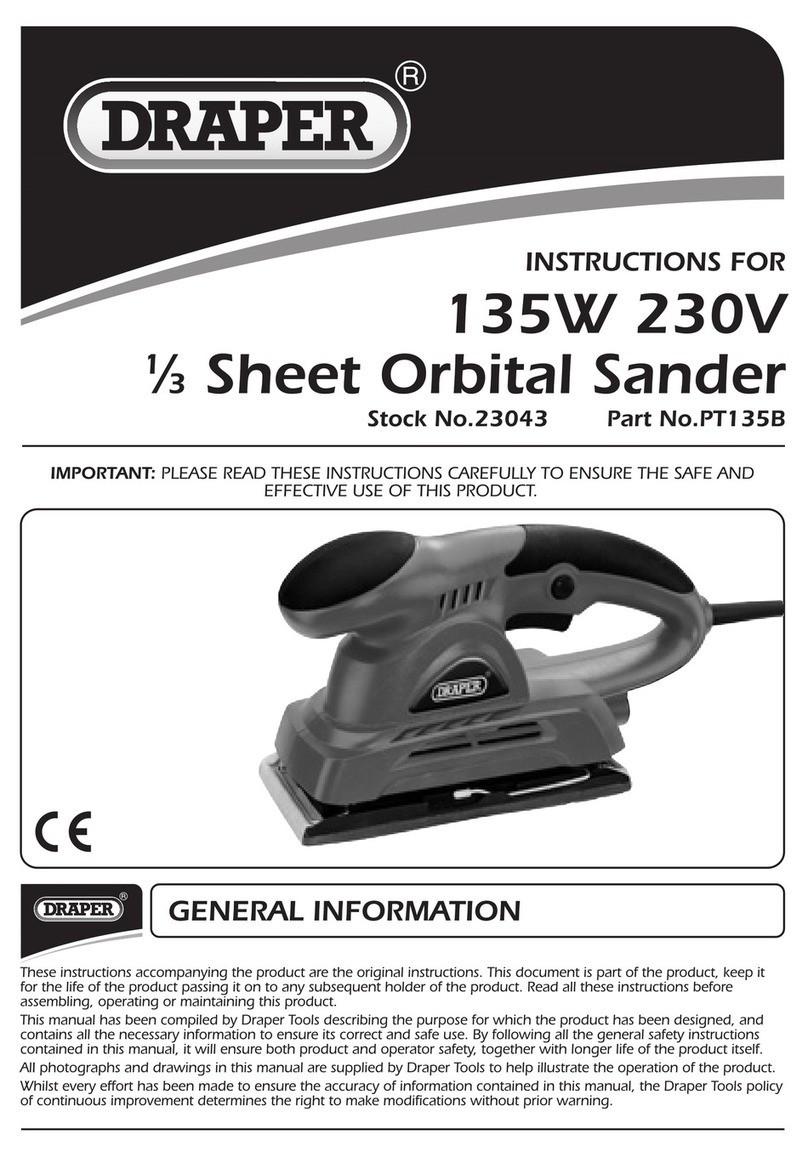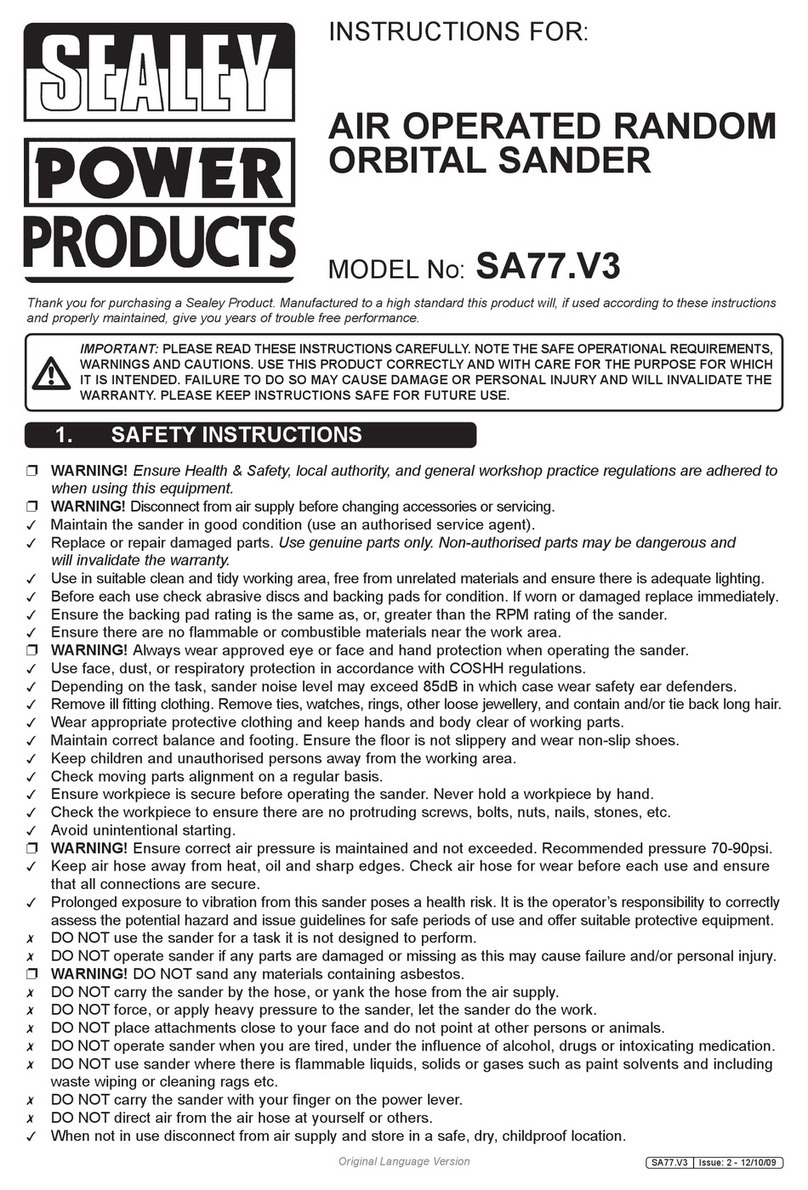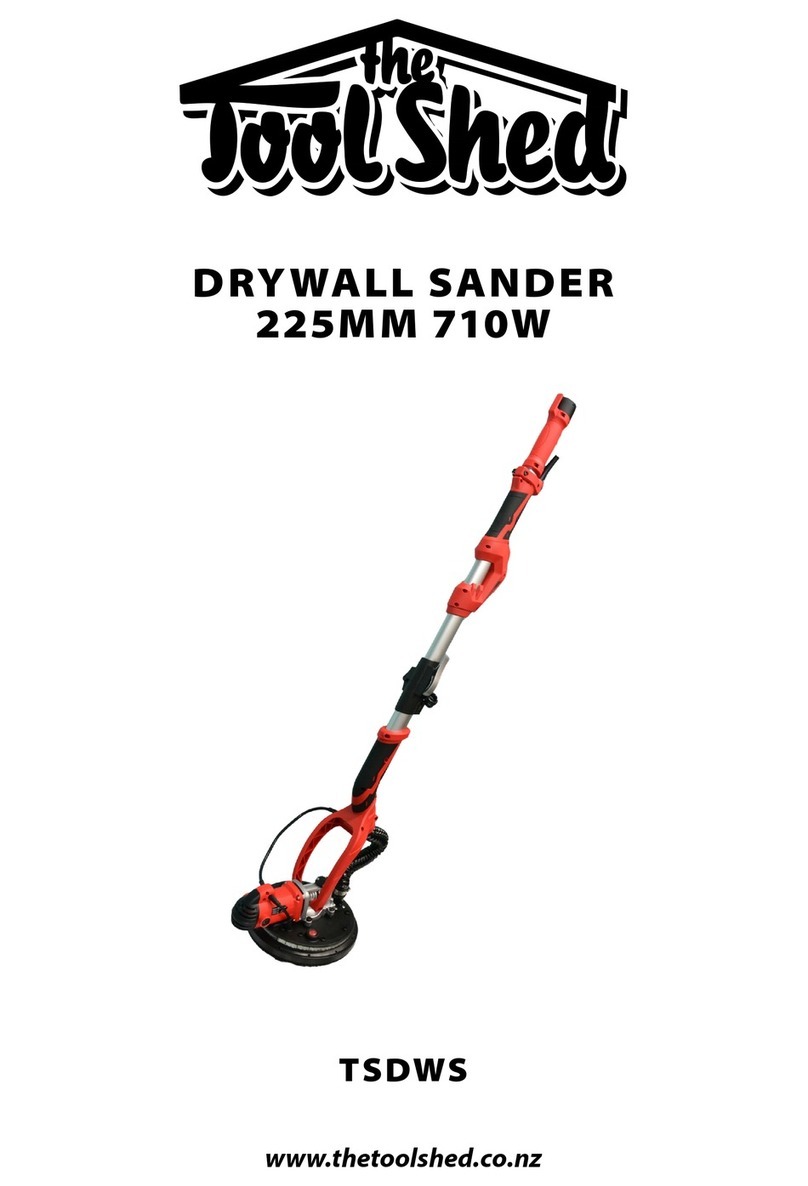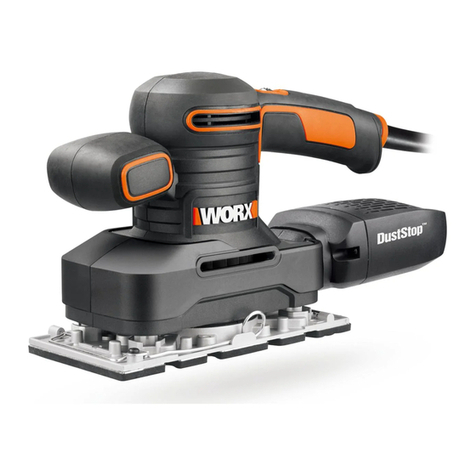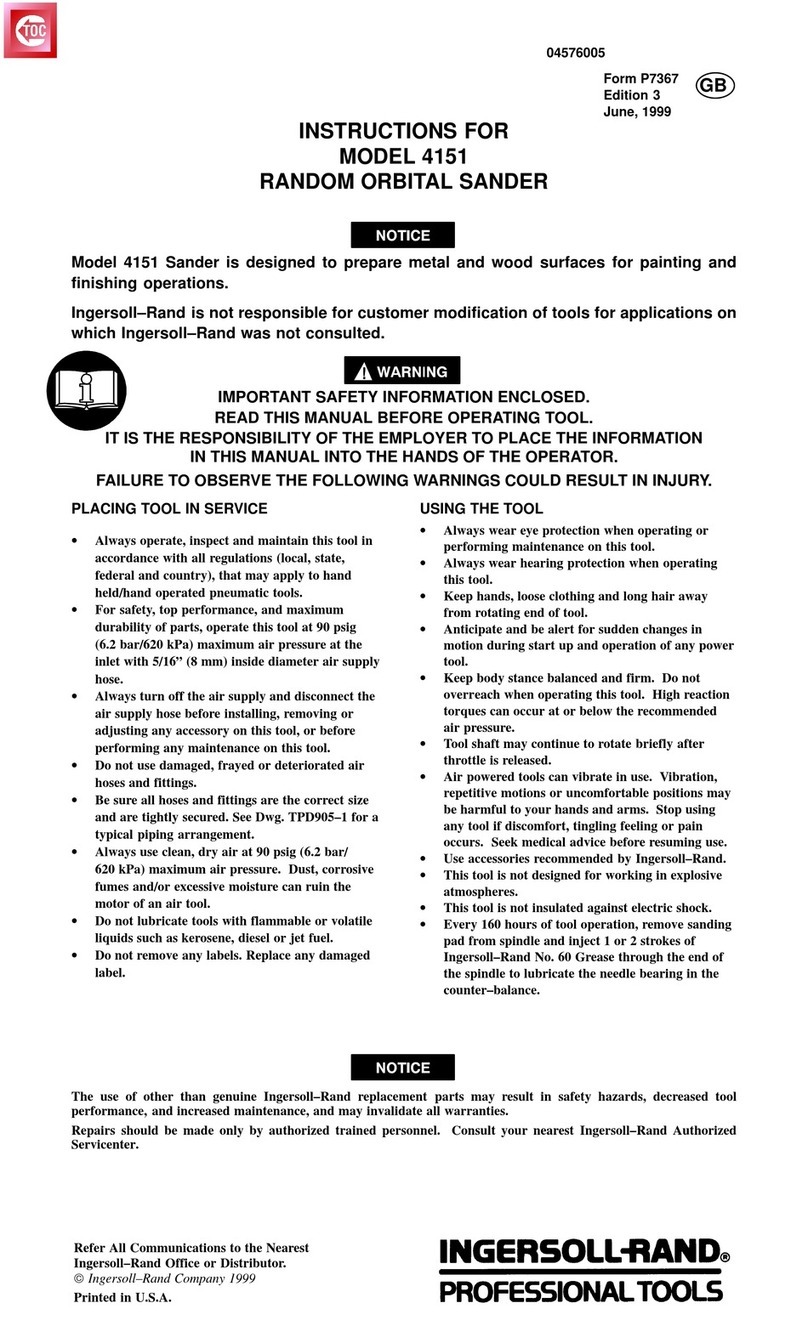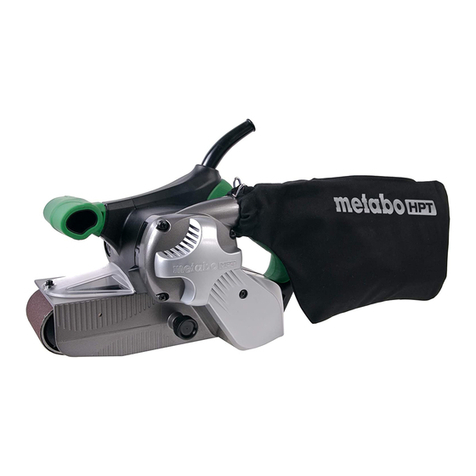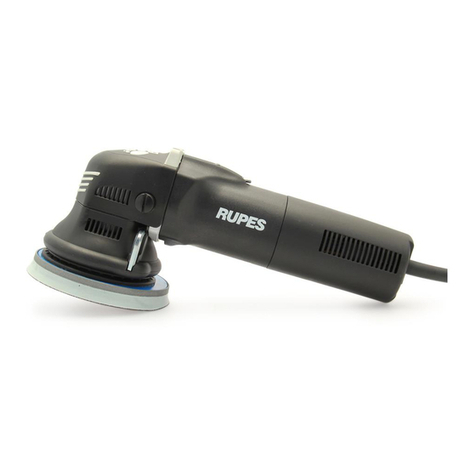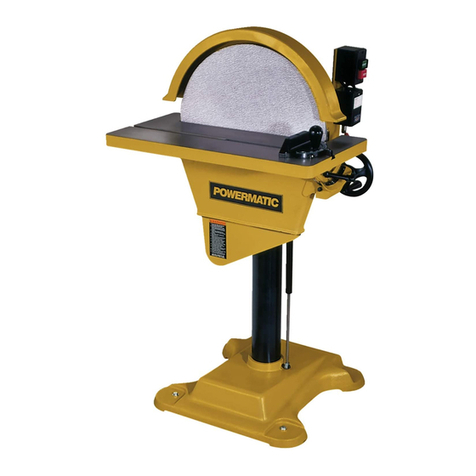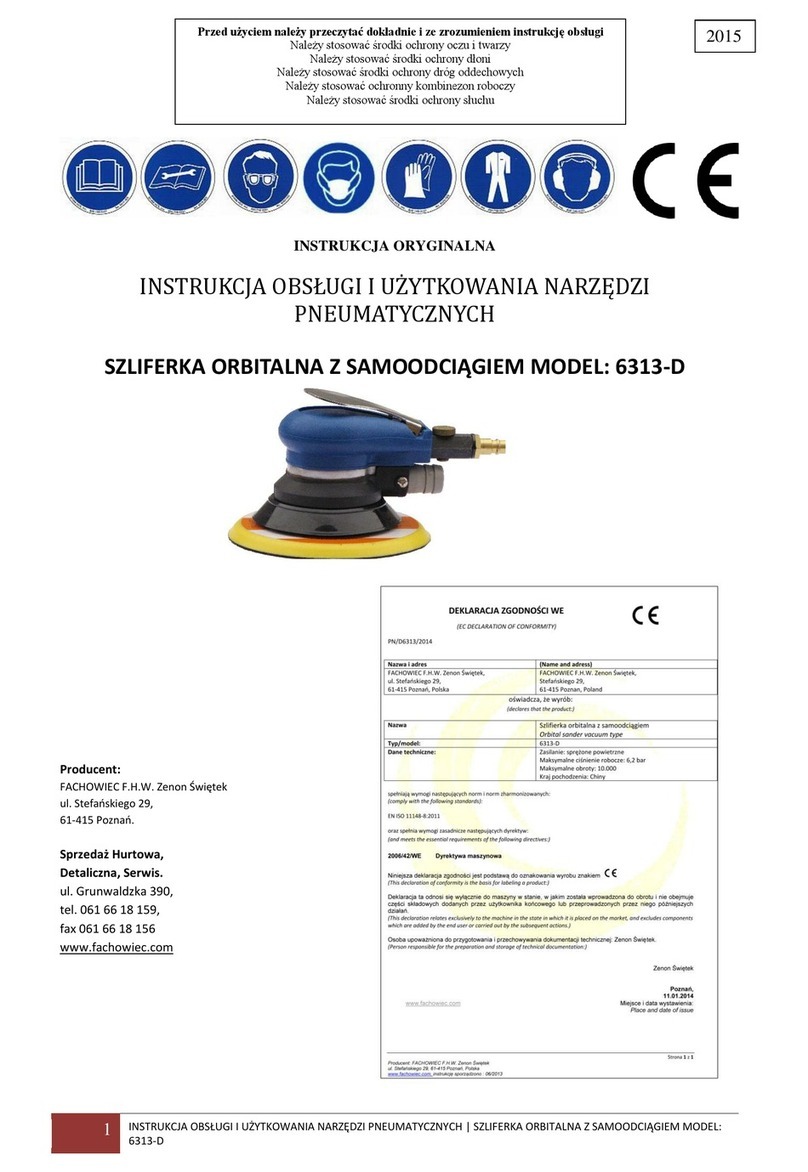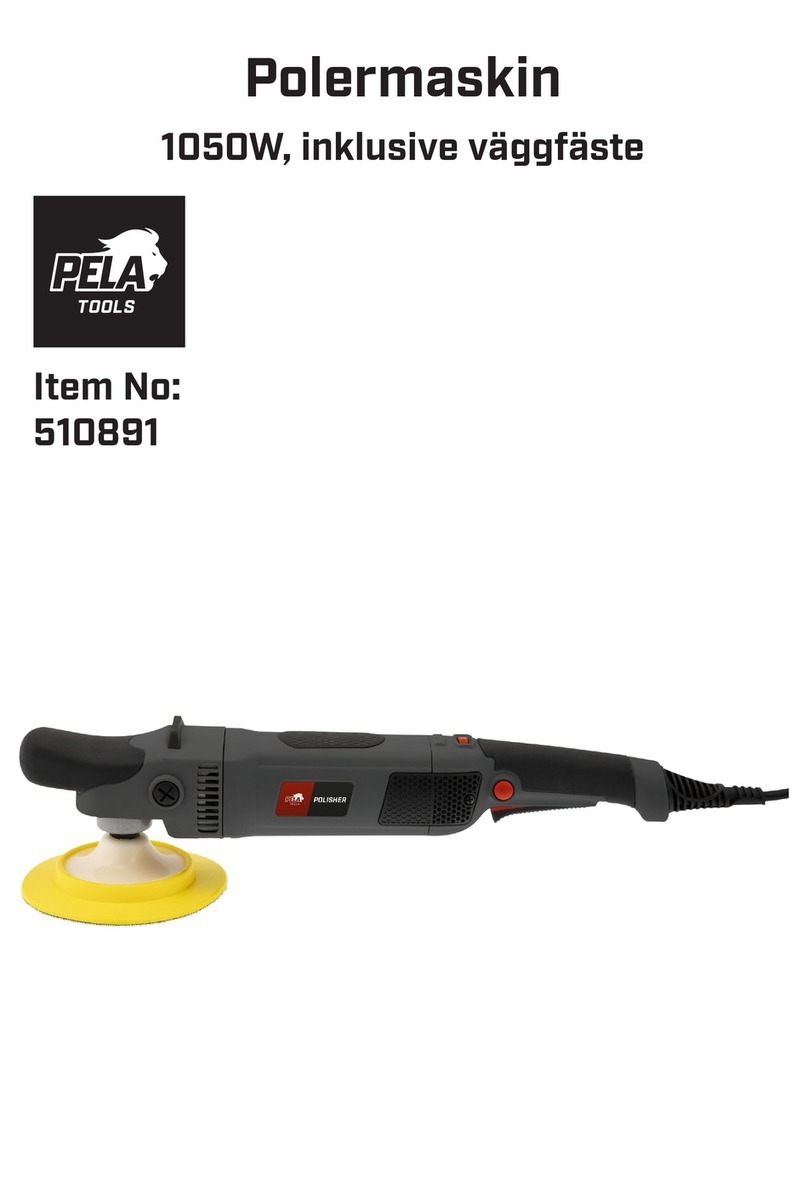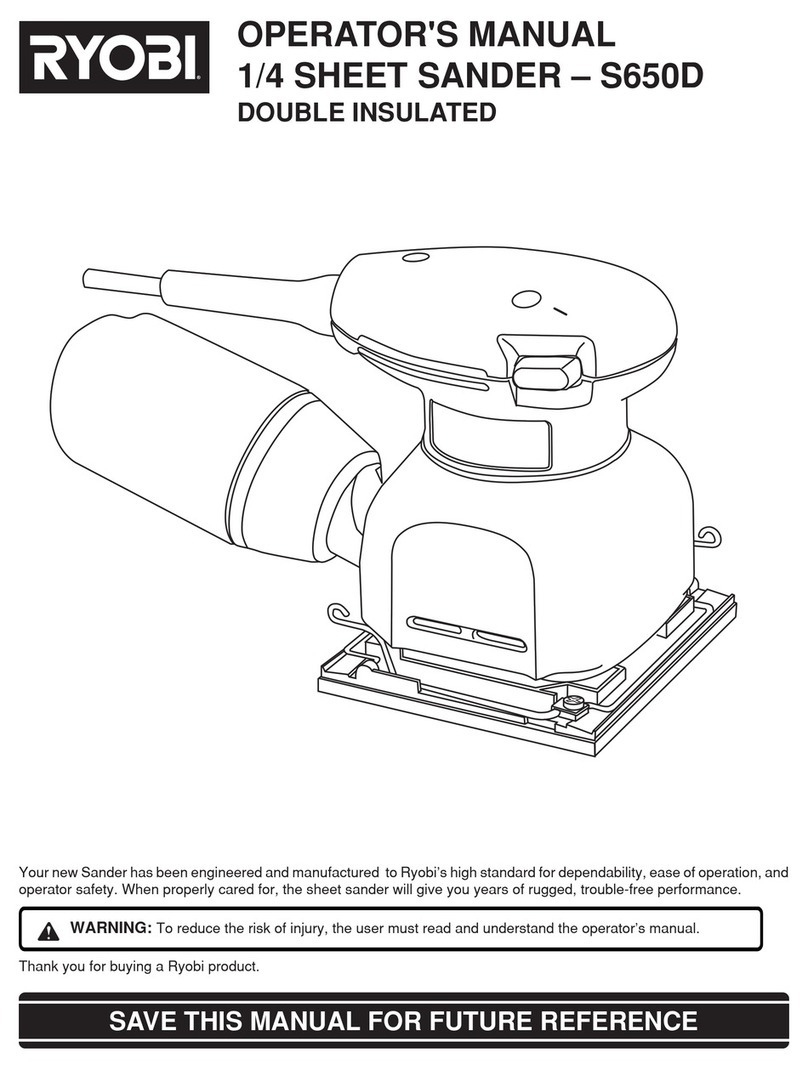Toolshop 241-9801 User manual

SAVE THIS MANUAL
You will need this manual for safety instructions, operating procedures and warranty.
Put it and the original sales receipt in a safe dry place for future reference.
Operator’s Manual
3” X 21”
VARIABLE SPEED BELT SANDER
241-9801

2
IMPORTANT SAFETY INSTRUCTIONS
WARNING:When using electric tools, machines or equipment, basic safety
precautions should always be followed to reduce the risk of fire, electric
shock, and personal injury.
READ ALL INSTRUCTIONS BEFORE USING THIS TOOL
1. KEEP WORK AREA CLEAN. Cluttered areas invite injuries.
2. CONSIDER WORK AREA ENVIRONMENT. Don’t use power tools in damp,
wet, or poorly lit locations. Don’t expose your tool to rain. Keep the work area
well lit. Don’t use tools in the presence of flammable gases or liquids.
3. KEEP CHILDREN AND BYSTANDERS AWAY. All children should be kept
away from the work area. Don’t let them handle machines, tools or extension
cords.
Visitors can be a distraction and are difficult to protect from injury.
4. GROUNDED TOOLS must be plugged into an outlet that itself is properly
installed and grounded. Grounding provides a low-resistance path to carry
electricity away from the operator, should the tool malfunction electrically.
Do not remove the grounding prong from the plug or alter the plug in any
way. If in doubt as to whether the outlet is properly grounded according
to code, check with a qualified electrician.
5. OBSERVE PROPER PRECAUTIONS REGARDING DOUBLE INSULA-
TION. This tool is double insulated. It is equipped with a polarized plug.
One blade is wider than the other, so it will fit into a polarized outlet only one
way. If you have difficulty inserting the plug, try reversing it. If it still doesn’t
fit , do not alter the plug; have a qualified electrician install a polarized outlet.
6. GUARD AGAINST ELECTRIC SHOCK. Prevent body contact with grounded
surfaces: pipes, radiators, ranges, and refrigerator enclosures. When your
body is grounded the risk of electric shock increases. When working wher-
ever “live” electrical wires may be encountered, try to ascertain whether
there is a danger of shock. Even so, DO NOT TOUCH ANY METAL PARTS
OF THE TOOL while using it. Hold the tool only by the plastic grip to prevent
electric shock if you contact a live wire.
7. DO NOT ABUSE THE CORD. Never carry your tool by the cord or pull on
the cord to unplug it. Protect the cord from potential sources of damage:
heat, oil & solvents, sharp edges, or moving parts. Replace damaged cords
immediately.
8. WHEN WORKING OUTDOORS, USE AN OUTDOOR-RATED EXTENSION
CORD. An extension cord rated for outdoor use must be marked “W-A” or
“W”.
9. DO NOT EXPOSE ELECTRICAL POWER TOOLS TO MOISTURE. Rain or
wet conditions can cause water to enter the tool and lead to electric shock.
10. ENSURE THE EXTENSION CORD YOU USE IS OF SUFFICIENT GAUGE
FOR ITS LENGTH.
11. STORE IDLE EQUIPMENT. Store equipment in a dry area to inhibit rust.
Equipment also should be in a high location or locked up to keep out of
reach of children.
12. DON’T FORCE THE TOOL. It will do the job better and more safely at the
rate for which it was intended.
13. USE THE RIGHT TOOL. Don’t force a small tool or attachment to do the
work of a larger industrial tool. Don’t use a tool for a purpose for which it was
not intended.
14. DRESS PROPERLY. Don’t wear loose clothing or jewelry; they can be
caught in moving parts. Protective, non-electrically conductive gloves and
non-skid footwear are recommended when working. Wear protective hair
covering to contain long hair and keep it from harm.
!
Recommended Minimum Wire Gauge for Extension Cords
Amps
from
Tool Nameplate
25’ length 50’ length 75’ length 100’ length 150’ length 200’ length
0-5 amps 16 ga. 16 ga. 16 ga. 14 ga. 12 ga. 12 ga.
5.1-8 amps 16 ga. 16 ga. 14 ga. 12 ga. 10 ga. Do Not Use
8.1-12 amps 14 ga. 14 ga. 12 ga. 10 ga. Do Not Use Do Not Use
12.1-15 amps 12 ga. 12 ga. 10 ga. 10 ga. Do Not Use Do Not Use
15.1-20 amps 10 ga. 10 ga. 10 ga. Do Not Use Do Not Use Do Not Use

15. USE EYE PROTECTION. Use a full-face mask if the work you’re doing
produces metal filings, dust or wood chips. Goggles are acceptable in other
situations. Wear a clean dust mask if the work involves creating a lot of fine
or coarse dust.
16. SECURE WORK. Use clamps or a vise to hold the work. It’s safer than using
your hands and it frees both hands to operate the tool.
17. DON’T OVERREACH. Keep proper footing and balance at all times. Do not
reach over or across machines that are running.
18. MAINTAIN TOOLS WITH CARE. Keep tools sharp and clean for better and
safer performance. Follow instructions for lubricating and changing accessories.
For safe performance, keep handles dry, clean and free from oil and grease.
19. AVOID UNINTENTIONAL STARTING. Be sure the switch is in the OFF posi-
tion before plugging in.
20. ALWAYS CHECK AND MAKE SURE TO REMOVE ANY ADJUSTING KEYS
OR WRENCHES before turning the tool on. Left attached, these parts can fly
off a moving part and result in personal injury.
21. DO NOT USE THE TOOL IF IT CANNOT BE SWITCHED ON OR OFF.
Have your tool repaired before using it.
22. DISCONNNECT THE PLUG FROM POWER BEFORE MAKING ANY AD-
JUSTMENTS. Changing attachments or accessories can be dangerous if
the tool accidentally starts.
23. STAY ALERT. Watch what you are doing & use common sense. Don’t operate
any tool when you are tired.
24. CHECK FOR DAMAGED PARTS. Before using this tool, any part that is
damaged should be carefully checked to determine that it will operate prop-
erly and perform its intended function. Check for alignment of moving parts,
binding of moving parts, breakage of parts, mountings, and other conditions
that may affect its operation. Inspect screws and tighten any ones that are
loose. Any part that is damaged should be properly repaired or replaced by
an authorized service center unless otherwise indicated elsewhere in the in-
struction manual. Have defective switches replaced by an authorized service
center. Don’t use the tool if switch does not turn it on and off properly.
25. REPLACEMENT PARTS. When servicing, use only identical replacement
parts.
26. SERVICE AND REPAIRS should be made by qualified repair technicians at
an authorized repair centre. Improperly repaired tools could cause serious
shock or injury
IMPORTANT SAFETY INSTRUCTIONS
SAFETY PRECAUTIONS FOR BELT SANDERS
3
HOLD TOOL BY THE INSULATED GRIPPING SURFACES WHEN PER-
FORMING AN OPERATION WHERE THE CUTTING TOOL MAY CONTACT
HIDDEN WIRING OR ITS OWN CORD. Contact with a “live” wire can cause
exposed metal parts of the tool to become “live” and shock the operator.
HOLD THE TOOL FIRMLY WITH BOTH HANDS on the hand grips.
MAKE SURE THE BELT IS NOT CONTACTING THE WORKPIECE BEFORE
THE TOOL IS TURNED ON.
KEEP HANDS AWAY FROM ROTATING PARTS.
DO NOT LEAVE THE TOOL RUNNING with the trigger locked. Operate only
while holding the sander. Before plugging the tool in, be sure the trigger is “Off”.
THIS TOOL IS NOT DESIGNED FOR USE WITH WATER OR, FOR WET
SANDING.
USE SPECIAL PRECAUTIONS WHEN SANDING MATERIALS IMPREGNAT-
ED OR COATED WITH TOXIC CHEMICALS EITHER AS A PRESERVATIVE
OR LEAD-BASED PAINTS. Use appropriate breathing apparatus and skin
covering. Take precautions as well to prevent contamination of the environment
with dust containing these persistent toxins. Check with your material supplier
as to any possible toxicity.
Keep the tool housing and handle clean and free of oil and grease using mild
soapy water.

SPECIFICATIONS
120 volts AC, 7.2 Amps
Sanding Belt size: 3” x 21”
Variable speed dial: 393-1,240 SFPM
Padded handle insert
Dust bag
Double Insulated
C-UL US listed
APPLICATIONS
Sanding of wood and other materials
Paint and rust removal
SWITCH
CAUTION: A sanding belt may have been installed at the factory and the belt
tracking may not be set correctly. Follow steps 5 & 6 in REMOVING, INSTALLING,
in REMOVING, INSTALLING, and ADJUSTING BELTS, below.
CAUTION: Before plugging the tool in, squeeze the trigger once and release it to
be sure the trigger is “Off” and not locked “On”.
CAUTION: Be sure the belt is not in contact with the workpiece when starting the
tool.
Lift the tool off the workpiece, with one hand holding the handle at the front and
the other grasping the handle at the rear.
Squeeze the trigger in the rear handle with your index finger to start the tool.
Release it to stop.
To lock the trigger in the “On” position, press the small round button on the
left side of the rear handle with your thumb at the same time as the trigger is
squeezed fully with your index finger.
REMOVING, INSTALLING, and ADJUSTING BELTS
WARNING: To prevent injury, always switch off and disconnect the tool from power
source before removing or installing the sanding belt.
1. Pull the belt tension lever from the right side of the sander and move it towards
the front of the machine. This pulls the idler (front) pulley back. The old belt
can be slid easily off the pulleys.
2. Check that the new 3”x 21” belt’s direction arrow (usually printed on the inside
fabric backing of the belt) matches the direction of belt travel on the tool. The
belt will move from the front to the back on the bottom, exposed surface of the
tool. A belt installed backwards will not work as efficiently and have a short-
ened life.
3. Slide a 3”x 21” abrasive belt over the front and back pulleys and line it up so
that it is as close to centered, with as little overhang as possible on both sides
at both the front idler pulley and at the back drive pulley.
A. ON - OFF Switch
B. Lock on button
C.
D.
Dust extraction outlet
E.
Belt tracking knob
Variable speed switch
FUNCTION DESCRIPTION
OPERATING PROCEDURES
AB
C
D
E
4

5
4. Push the tension lever back into the closed position. Take care not to pinch
your fingers. The belt is now clamped in place.
5. Be sure the switch is off. Plug the tool in. The following may be easier if the
tool is held upside down, resting on a bench. Do not let the abrasive belt con-
tact anything.
6. Before starting the tool, re-set the belt drive tracking by turning the knob clock-
wise until resistance is felt and then back it of about 1 turn counterclockwise.
Squeeze the trigger and run the tool slowly.
If the belt starts to move to the left or right of the pulleys, the tracking should
be adjusted more. This can be done by turning the tracking knob at the front
left side of the tool. Turning the knob clockwise causes the belt to track toward
the left. If you turn the knob the other way, the belt will track toward the right.
Adjust until belt runs in the center without touching the housing on the left side
of the tool or running off the pulleys on the right. The belt should not be more
than 6mm (1/4”) away from the edge of the bottom plate. If the belt touches the
housing, fraying and shortened belt life as well as damage to the housing will
result.
7. After running a new belt on a work piece for a short time, the tracking may need
more adjustment.
DUST BAG
Fit the dust bag over the dust port on the left side of the sander near the rear
handle. Dust extraction is most efficient if the bag is emptied whenever it reaches
half full. Once in a while, it may be beneficial to turn the bag inside out and
thoroughly clean it with a brush.
Do not use this sander without some form of dust collection.
SANDING
1. Secure the work piece well. It will tend to move toward the operator while the
sander is running in contact with the surface.
2. Hold the tool firmly with both hands on the hand grips. When the belt comes
in contact with the work surface, the tool will tend to pull itself forward quite
strongly. To prevent damage to the material and the belt, never start the sander
while the belt is in contact with the work surface.
3. Turn the tool on and let it come up to speed.
4. Gently lower it keeping the bottom plate roughly parallel with the surface.
5. Begin moving the sander forward. Drop the back very slightly so the belt
contacts the work surface first at the rear, the heel of the sander. Continue to
move the tool forward as you bring the belt into full contact with the surface.
Use only very light downward pressure, if any.
6. Move the tool back. Continue this back and forth motion in overlapping strokes
while sanding. This helps provide an even surface. Avoid putting weight on
the tool as its own weight is usually sufficient. Too much weight can result in
gouging and burning the surface, overloading the motor, and having the work
piece kick back.
7. When sanding a rough wooden surface, placing the sander a slight angle to the
grain, using a coarse grit, while moving the sander itself back and forth with the
grain, may help speed stock removal. The same technique can be carried on
through the medium grits. On the finishing grits, the sander should be oriented
with the grain.
8. When finished sanding, lift the sander off the surface before releasing the
trigger.
Sanding direction is not critical on most materials other than wood, since grain
direction is not a concern.
Sanding flush against a perpendicular surface is possible along the right side of
the tool.
OPERATING PROCEDURES

OPERATING PROCEDURES
MAINTENANCE
Use a grade of sandpaper that will make finer marks than those already on the
surface. Too coarse a grade will not make the surface smoother while too fine a
grade will remove scratches too slowly, or not at all. Continue using finer grades of
sandpaper until you obtain the desired finish.
When removing old paint, determine how much paint really needs to be removed.
Consider that old paint may well be toxic and will have to be treated with the
respect due any toxic material both on the part of the tool operator and on the part
of the environment. Wear appropriate breathing protection and dispose carefully of
dust or chips left after sanding could be tracked throughout residences and release
toxins into the soil. Use the provided dust bag as well. A finish that is cracking or
flaking has to be taken off, but a finish that is still firmly attached can be “roughed
up” and painted over with primer and the new finish. Always lightly sand the
undercoat with fine grade sandpaper before applying the top coat.
Keep the vents clear of dust and debris. This will help prevent possible
electrical shorts and ensure proper cooling.
Keep the tool housing clean and free of oil and grease using mild soap and a
damp (not wet) cloth.
Avoid overloading your sander. It will become hot and lose efficiency. Running
it free of load for a minute or two will allow it to cool itself to normal temperature.
Inspect the cord regularly and have it replaced by an authorized repair facility if
it is damaged.
Lubrication for this tool is done at the factory and should not be necessary
again under normal use.
An authorized repair centre should do any repairs, modification, or maintenance
that involve disassembling the tool.
Any damage to the tool should be corrected at an authorized repair center.
6

7
PARTS LIST AND SCHEMATIC DRAWING
Item no.
1
2
3
4
5
6
7
8
9
10
11
12
13
14
15
16
17
18
19
20
21
22
23
24
25
26
27
28
29
30
31
32
33
Item no.
34
35
36
37
38
39
40
41
42
43
44
45
46
47
48
49
50
51
52
53
54
55
56
57
Part name and spec
Sanding belt
Screw ST4.8×20
Front-cover
Bottom plate
Front-wheel frame left
Front-wheel frame right
Spring
Front-wheel frame
Retaining
Front-wheel
Needle bearing
Ring washer
Subsidiary nameplate
Screw ST4.8×20
Right housing
Soft grip
Bearing 626
Rear wheel axis
Rear wheel
Ring washer
Oil bearing
Rotor
Grip
Screw ST4.8×20
Cable clamp
Cable plug
Cable cover
Switch
Shift-switch
Left housing
Bearing 608Z
Big gear
Pin Φ 3
Part name and spec
Retaining
Bearing 606Z
Shaft gear
Bearing 608RS
Middle cover
Screw ST4.2×14
Small-belt-wheel
Timming-Belt
Belt cover
Screw ST4.2×14
Cover board
Fan guide
Brush holder cover
Carbon-brush
Carbon-brush holder
Adjust-nut
Wave-over Φ 8×Φ 12
Close-over Φ 8× Φ 12
Retaining 06
Adjust spring
Stator
Close over Φ 5
Screw ST4.8×50
Insolated washer

8
!
WARNING: Repairs should be made by an authorized repair center. Do not open or
disassemble this power tool. Contact at 1-866-915-8626 for questions regarding
this power tool.
PARTS LIST AND SCHEMATIC DRAWING

9
TOOL SHOP®
1-YEAR LIMITED WARRANTY:
This TOOL SHOP® brand power tool carries a 1-YearLimited Warrantyto the
originalpurchaser. If the tool fails within one (1) year from the date of
purchase, simply bring this tool with youroriginal sales receipt back to your
nearest MENARDS® retail store. At its discretion, TOOL SHOP® agrees to
have thetool replaced with the same or similar TOOL SHOP® product free of
charge, within the stated warrantyperiod, when returnedbythe original
purchaser with original sales receipt. Notwithstanding the foregoing, this
limited warrantydoes not cover anydamage that has resulted from abuse or
misuse of the Merchandise. This warranty: (1) excludesexpendable parts
including butnot limited to blades, belts, bits, light bulbs, and/or batteries; (2)
shall be void if this tool is used for commercial and/or rental purposes; and (3)
does not cover any losses, injuries to persons/property or costs. This
warrantydoes give you specific legal rights and you may have other rights,
which vary from state to state. Be careful, tools are dangerous if improperly
used or maintained. Seller’s employees are not qualified to advise you on the
use of this Merchandise. Any oral representation(s) made will not be binding
on seller or its employees. The rightsunderthis limited warrantyare to the
originalpurchaser of the Merchandise and may not be transferred to any
subsequent owner. This limited warranty is in lieu ofall warranties,
expressed or implied including warranties or merchantability and fitness fora
particular purpose. Seller shall not be liable forany special, incidental, or
consequential damages. The sole exclusive remedy against the seller will be
forthe replacement of anydefects as provided herein, as longas the seller is
willing orable to replace this product or is willing to refund thepurchase price
as provided above. For insurance purposes, seller is notallowed to
demonstrate any of these power tools for you.
For questions / comments, technical assistance or repair parts –
Please call toll free at: 1-866-915-8626
(M-F 8am – 5pm EST)
SAVE YOUR RECEIPTS. THIS WARRANTY IS VOID WITHOUT THEM.
3” X 21”VARIABLE SPEED BELT SANDER WARRANTY
This manual suits for next models
1
Table of contents
Other Toolshop Sander manuals
